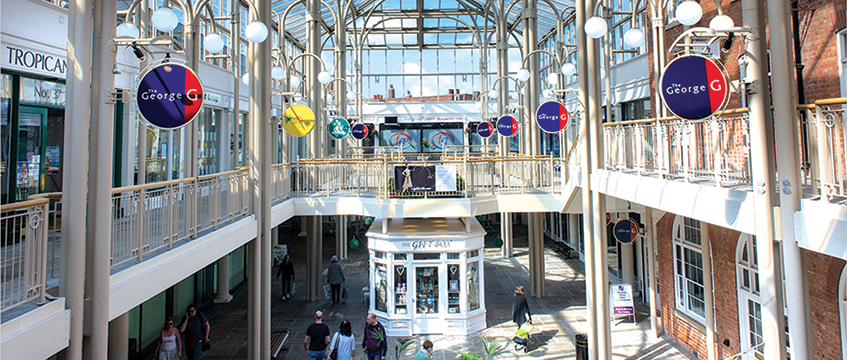This summer, shopping centre body Revo launched a consultation looking into the need to redefine the different types of UK shopping centres so that they are in line with international industry standards.
The objective is to more accurately describe the different types of centres so investors can more easily understand assets – as opposed to shopping centres being labelled simply primary or secondary.
Here, two experts argue in favour of reclassification and against, arguing that it is reinvention that retail really needs.
FOR: Lawrence Hutchings, chief executive, Capital & Regional
I have written before that the UK retail market and retailers are among the best in the world; however, one area where we are out of step with the other developed shopping centre and retail investment markets is the classification of retail assets as “primary” and “secondary”.
To some this may seem like a technical point, but I believe the outdated model is an obstacle for property owners in what is already a challenging retail market.
The labelling of assets as primary or secondary is subjective and too simplistic, and the continued evolution in retailing dictates the need for greater levels of understanding as to the role different types of retail venues fill in communities across the UK.
Differentiation
A note from JP Morgan touched on the frustrations caused by the current classification, calling for a need for “differentiation between retail sub-sectors”, which would help lenders, analysts and retailers alike better understand the relative performance of assets, and encourage more nuanced commentary on the market.
The introduction of a new formal classification model would also bring the UK in line with the US, Europe and other retail markets, which can only be a good thing, as the sources of capital, investors, retailers and suppliers are global in today’s connected economy.
We fully support the consultation launched by Revo to help redefine UK shopping centres, and will be providing our own thoughts and analysis on how we should move on from the current terminology.

To properly define UK shopping centres we need to consider their scale and anchoring, catchment size and the mix of retail, food service, convenience, services and leisure.
Moreover, I believe a shopping centre is defined by its purpose – and the degree to which it fulfils the wants or needs of its visitors.
By looking at shopping centres in this way we would identify several defined asset types, ranging from retail and leisure destinations to regional and major centres to community, convenience and neighbourhood shopping.
“The labelling of assets as primary or secondary is subjective and too simplistic, and the continued evolution in retailing dictates the need for greater levels of understanding as to the role different types of retail venues fill in communities.”
At one end of the spectrum, a destination centre is partly defined by its focus on wants-based retail, offering comparison goods and capturing the less frequent, discretionary spend of a larger catchment.
Meanwhile community, neighbourhood and functional centres are oriented, to varying degrees, towards the needs of their catchment, are more value-focused and benefit to a greater extent from essential, non-discretionary spending.
Indeed, it is the range of assets focused on needs which are proving to be the most productive for retailers, delivering the most attractive sales-to-rent ratios. Many of the retailers I speak to describe these locations as the engine room of their business, which belies their description as “secondary” assets.
We need a better means of classifying shopping centres, but we also need to change how we think about the relationship between retail places. This is not a hierarchy, with assets ranked in descending order, but an ecosystem in which centres are complementary and interdependent.
Evidence
I see evidence of this in our own portfolio, where our community centre at Ilford thrives within the catchment area of Westfield Stratford because they satisfy very different customer missions.
Westfield is a destination centre with over 80% of its retail offer focused towards wants and has a strong leisure offer including bowling, a cinema, casino and gym. Our centre at Ilford serves a local catchment with a very different mission, offering a retail mix more centred on everyday needs and providing services such as a post office, dentist and travel agents, alongside entertainment. Our guests or shoppers visit both centres and understand the different roles they fill.
I haven’t met a retailer or a guest who refers to our community centres as “secondary” – this definition is out of step with the role these centres play in their local communities. It’s about time we all started talking the same language as our customers.
AGAINST: Barry Jessup, director, First Base
“In real estate, as in real life, everything is cyclical, and it is amazing how often we end up back in the same place, often without realising it.
Two headlines, “Retail in crisis” and “High streets in crisis” appear in newspapers or online on an almost daily basis, and are seemingly used interchangeably, when neither is accurate, nor are they in any case the same thing.
The headlines typically refer to physical retailers which haven’t modernised their businesses, and which have real estate exposure far higher than they should. The writing has been on the wall for these businesses for a while, and putting aside concerns around job losses and consequential individual economic circumstances, we shouldn’t be losing any sleep over these. Instead, we should be thinking about how we reinvent these spaces so they reflect today’s shopping experience.
What has become clear over the past few years is that retailers or brands who want to create loyalty and charge a premium have as much demand for physical space as they have ever had.
“Reclassification of retail places is not enough; we need an update to planning use classes to allow the retail spaces of the future to be created.”
The new Samsung store in King’s Cross is a good example of this. Five years ago we introduced the idea of “brand pavilions” or “brand embassies” into our vision for Silvertown, and it is interesting to see these spaces becoming ever more prevalent in retail areas. Replacing faceless stores mostly interested in piling up stock for sale, with much more experiential and interactive brand spaces, is a significant improvement for most shoppers welcoming the likes of Apple and Dyson to the high street.

But the growth of these brand experiences hasn’t been without its challenges. Some less well informed planning authorities have threatened to close these stores as they don’t comply with the strict definition of their A1 planning use class as they may not be “selling” stock in store.
A more flexible and modern approach is required which considers the different ways we shop. Reclassification of retail places is not enough; we need an update to planning use classes to allow the retail spaces of the future to be created. This in turn is critical to the revitalisation of high streets and town centres across the UK.
Failure of ‘stack ’em high’ retailers
The reference to “crisis on the high street” is usually directly linked to the failure of the “stack-’em-high” retailers. This is, of course, nonsense. I would argue that the high street crisis was caused by the advent and the success of these bland stores in the first place. As the demand for these stores increased in the 1970s and 1980s, and misguided local authorities sought to attract them to their town centres, the resulting increase in car parking and service yards caused massive damage to the customer experience, and to the perception of the high street. It is hard to believe that as recently as this decade some local authorities still thought attracting a large supermarket to their town centre would help to revive it.
The failure of these large-format retailers provides a perfect opportunity to “fix” high streets up and down the country. High streets emerged as a practical response to everyday living; providing a convenient place to create, sell, play and live. Over a century after modern high streets became popular we have an opportunity to go full circle and to return to the broad mix of uses that made them successful in the first place.
Post-digital flexible lifestyle
City centre living has never been more popular. Decentralised modern office working reflecting today’s post-digital flexible lifestyle is in high demand. Brand-focused retailers are providing a bespoke customer experience like never before. The reduced requirement for stock delivery and a lessening reliance on the car in the era of autonomous vehicles reduces infrastructure stress. The successful combination of the above elements provides us with a once-in-a-lifetime opportunity to reinvigorate our high streets. All that is needed is a mixture of understanding, vision and flexibility, and we can deliver on the potential.
Are you for or against a reclassification? Tweet us your thoughts @estatesgazette using #retailreclassified











